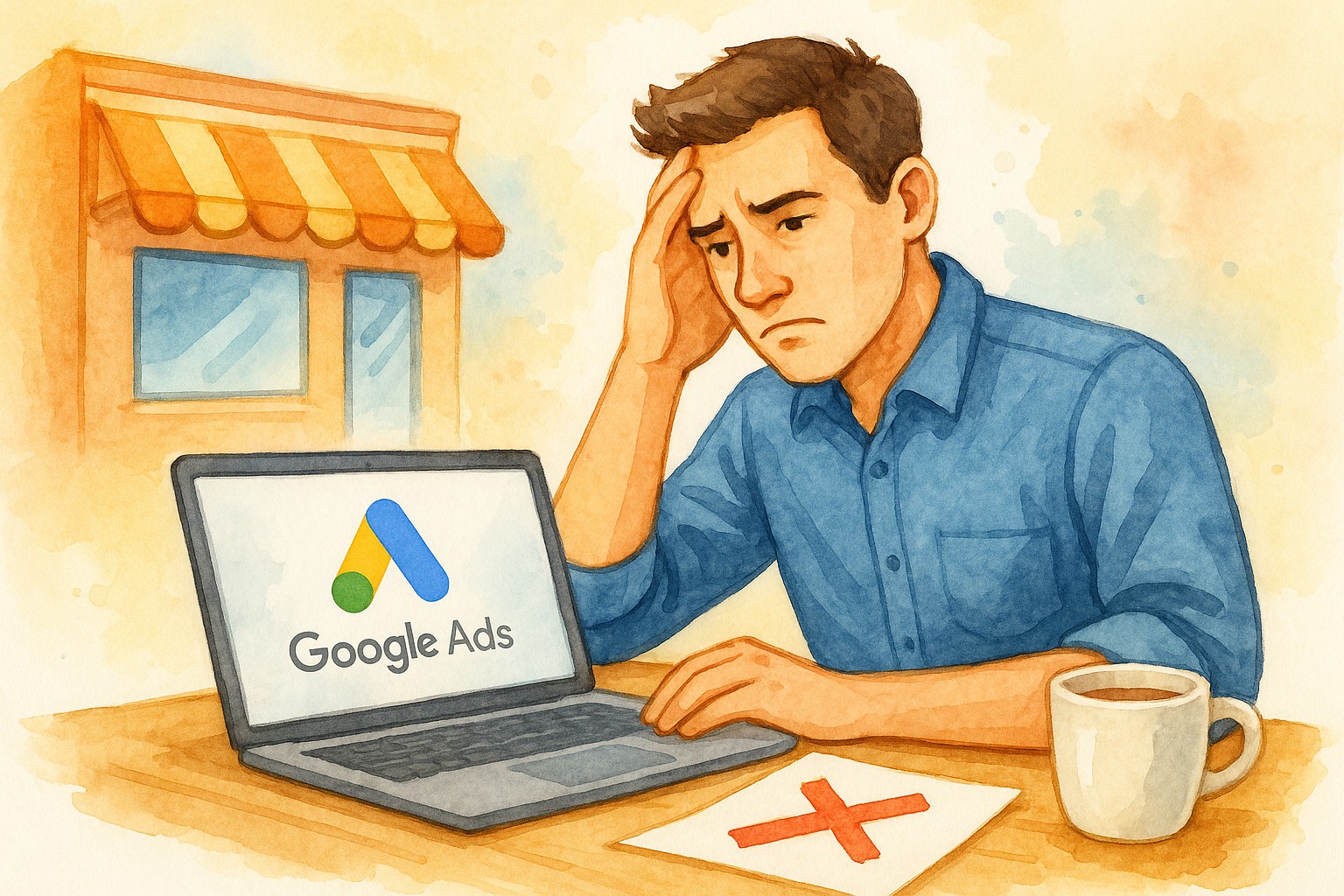Google Ads can be a total game-changer for local businesses looking to get more customers fast, but if you’re not careful, it’s easy to lose money and time. Most small-town businesses don’t have a huge marketing team, so every dollar counts. Here at https://brenham.buzz, we’ve seen firsthand how simple mistakes can cost local businesses big. The good news? Most Google Ads slip-ups are totally fixable. In this guide, we’ll break down the top seven mistakes local businesses make with Google Ads and show you exactly how to fix them for 2025.
7 Mistakes Local Businesses Make with Google Ads (And How to Fix Them in 2025)
Introduction
Running Google Ads might look easy on the surface—just pick some keywords, write a quick ad, and watch the leads roll in, right? Not so fast. The reality is, Google Ads is a powerful tool, but it’s also complex. Local businesses often dive in without a plan and end up wasting money, getting irrelevant clicks, or missing out on valuable customers. If you want your ads to actually deliver results, you need to avoid the most common pitfalls. In 2025, competition is only getting fiercer, so it’s more important than ever to tighten up your strategy. Let’s dive into the biggest mistakes—and how you can avoid them to get the best bang for your buck.
Mistake 1: Neglecting Keyword Research
One of the most common mistakes local businesses make with Google Ads is skipping over proper keyword research. It’s tempting to just choose a handful of obvious keywords—like “plumber near me” or “best coffee shop”—and call it a day. But this can lead to a lot of wasted ad spend on searches that don’t actually convert into customers.
Why is keyword research so important? If you’re not targeting the right keywords, your ads will show up in front of the wrong people. For example, a bakery in Brenham targeting just “cakes” might get clicks from people all over the country, instead of locals ready to buy today. Even worse, you could be paying for clicks from people looking for something your business doesn’t even offer.
Here’s a jaw-dropping stat to drive the point home: The average Google Ads account wastes 76% of its budget on the wrong keywords. That’s three out of every four dollars going straight down the drain! Taking the time to use Google Keyword Planner or tools like SEMrush can help you find keywords with high intent and local relevance. Don’t just guess—do your research, and make sure you’re targeting the search terms your potential customers are actually using.
Mistake 2: Ignoring Negative Keywords
Negative keywords are your secret weapon for keeping your Google Ads focused and efficient. But a lot of local businesses don’t even know they exist—or overlook their importance. Negative keywords are terms you tell Google NOT to show your ads for. For instance, if you own a pet grooming business, you might want your ad to show up for “dog grooming Brenham” but definitely not for “dog grooming jobs” or “DIY dog grooming.”
Ignoring negative keywords means you’ll end up paying for clicks from people who aren’t actually interested in your services. This leads to wasted budget and lower return on investment. Think about all the searchers who are just looking for free advice, job opportunities, or even products you don’t sell—they don’t convert, and they eat up your ad spend.
- Review your search terms report regularly to see what people are actually typing in when they click your ad.
- Add irrelevant terms as negative keywords to filter out unwanted traffic.
- Be proactive—think about all the potential ways someone might find your ad by accident and block those searches up front.
By building a solid negative keyword list, you ensure that your ads reach only the people who are most likely to become customers.
Mistake 3: Poor Ad Copy
Even if your keywords are spot-on, bad ad copy can kill your Google Ads performance. Writing ads that are too generic, boring, or unclear means people will just scroll past your listing—or worse, click without really understanding what you offer, leading to wasted clicks.
Great ad copy does a few things:
- Clearly explains what makes your business unique (your “unique selling proposition”)
- Uses local language and mentions your city or neighborhood
- Includes a strong call-to-action (like “Call today,” “Book now,” or “Visit our store in Brenham”)
- Highlights special offers, testimonials, or awards (if you have them)
Don’t just recycle what your competitors are doing—make your ads stand out! Test different versions of your headlines and descriptions to see what gets the best response. Remember, a well-written ad not only attracts more clicks, but also attracts the right clicks from people who are ready to become customers.
Mistake 4: Overlooking Ad Extensions
Ad extensions are extra bits of information you can add to your Google Ads—like your phone number, address, links to specific pages, or even extra text. These might seem like small details, but they can make a huge difference in your results.
Here’s a must-know fact: Google Ads campaigns with ad extensions have a 10-15% higher click-through rate. That means more people are clicking your ads, and you’re getting more chances to win new customers for the same budget.
Some of the most valuable ad extensions for local businesses include:
- Location extensions: Show your address and a map so people know exactly where you are.
- Call extensions: Add a click-to-call button, making it super easy for mobile users to reach you.
- Sitelink extensions: Direct customers to specific pages on your website, like your menu, services, or contact page.
- Callout extensions: Highlight special offers, free estimates, or unique selling points.
If you’re not using these, you’re missing out on valuable real estate on the search results page—and making it harder for potential customers to connect with you.
Mistake 5: Not Utilizing Conversion Tracking
Imagine running ads for months and having no idea which ones are actually bringing in customers. That’s what happens when you skip conversion tracking—and it’s a far too common mistake. Conversion tracking lets you see exactly which ads, keywords, and campaigns are leading to real business results, like phone calls, online bookings, or purchases.
Here’s why it matters: Google Ads campaigns with conversion tracking outperform those without by 50%. If you’re not tracking conversions, you’re basically flying blind—optimizing for clicks, not customers.
Setting up conversion tracking is easier than you think. You can track actions like:
- Form submissions (like “Request a Quote” or “Contact Us” forms)
- Phone calls from your website or ads
- Online purchases or bookings
- Newsletter sign-ups
Once tracking is in place, you can spot which ads are working, which need improvement, and which are just wasting your money. This helps you double down on what’s working and cut the rest.
Mistake 6: Failing to Optimize Landing Pages
Sending ad clicks to a generic homepage is another classic blunder. If your Google Ads send people to a page that doesn’t match what they’re looking for, they’ll bounce fast—and you’ll pay for the privilege. A well-optimized landing page is designed specifically to convert visitors who clicked your ad.
Here’s what a great landing page does:
- Directly matches the offer, service, or product mentioned in your ad
- Makes it easy to take the next step (call, book, buy, etc.)
- Loads quickly and looks great on mobile devices
- Includes trust signals like testimonials, reviews, or guarantees
Don’t forget: The average conversion rate in Google Ads is 3.75% across all industries. If your conversion rate is lower than that, it’s time to look at your landing pages. Test different headlines, images, and calls-to-action to see what works best for your audience.
Mistake 7: Mismanaging Budget Allocation
Google Ads can eat through your budget in a hurry if you’re not careful. Many local businesses either spread their budget too thin across too many campaigns or spend too much on underperforming ads. Both mistakes mean you’re not getting the most value for your money.
It’s important to:
- Focus your budget on the campaigns and keywords that deliver real results (based on your conversion tracking data!)
- Set daily and monthly limits to avoid nasty surprises
- Regularly review your cost per click (CPC) and adjust bids as needed
For context: The average cost per click (CPC) in Google Ads across all industries is $2.69. If you’re paying way more without seeing results, something’s wrong. Prioritize your highest-performing campaigns and don’t be afraid to pause or reduce budget on ads that aren’t converting.
Conclusion
Google Ads can deliver incredible results for local businesses—but only if you avoid these common mistakes. From targeting the right keywords and using negative keywords to writing compelling ad copy, leveraging ad extensions, tracking conversions, optimizing your landing pages, and managing your budget wisely, every step matters. The digital landscape is always evolving, and what worked last year might not cut it in 2025. If you want to grow your business and get the most out of every advertising dollar, keep these tips in mind. Need expert help or local insights? The team at https://brenham.buzz is always here to help you take your Google Ads performance to the next level.


Leave a Reply